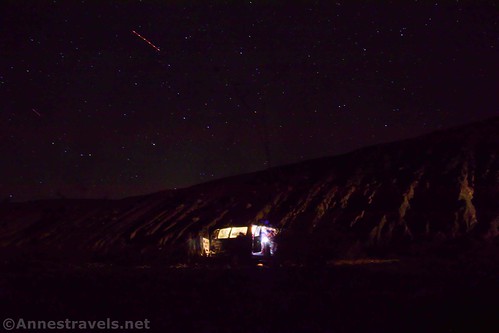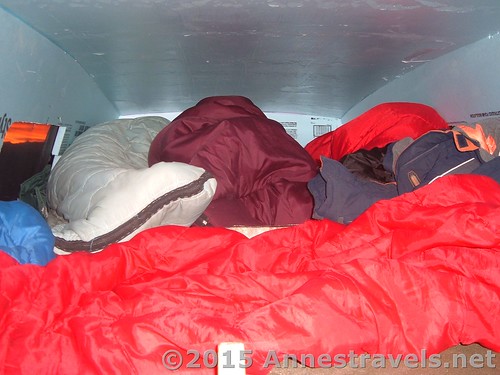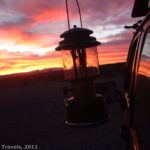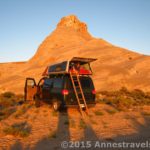The more I travel, the more people I find who sleep in their vehicles. There are just so many pros to sleeping in your car, SUV, or van:
- No more wet tents to dry out
- Setup time is usually minimal
- Camping in a vehicle is a lot less noticeable than in a tent
- Campgrounds are cheaper than hotels (usually) and you can often find places to park for free
- Mattresses and seats are softer than the hard ground
- Less gear (no tents, ground pads, rain tarps, etc.)
- Less worry of a bear or raccoon crawling in with you at night

Of course, there are cons, too:
- Pretzel crumbs in your sleeping bag (eww!)
- Most seats aren’t long enough to sleep comfortably
- You’re suddenly considered an RV (in some places)
- Some campsites are… more reputable than others
- People thinking you’re homeless when you’re really just on vacation
- Gear everywhere, including on your bed!

But here’s the real question: Just what do you need to do before you begin sleeping in your vehicle on road trips and camping trips?
I started sleeping in my full-size van with my family of (then) eight many years ago. That meant two adults, two near-teens, and four children – all sleeping in a van. We still took our “Big Blue” tent for a few trips until it became apparent that we simply weren’t going back to tent camping. Sleeping in the van was just so much more convenient, cost-effective, and comfortable!
You really don’t *need* a lot of special equipment to sleep in your vehicle. You also don’t need to permanently modify the vehicle at all. I think the only semi-permanent modification we made was to attach binder clips to the already-installed screws to hang up our curtains. Here are a few things I’ve found that you really do need before beginning to camp in your car, van, SUV, or other vehicle.

- A vehicle. It doesn’t matter a whole lot what sort of vehicle you have – an acquaintance was a 6ft. guy who lived out of a compact car for years. Just in my circle of social media, I’ve seen SUVs, full-size vans, minivans, a Toyota Prius, RVs of all sizes, jeeps, and more. If you’re tall, consider using a vehicle with a bit more space unless you like sleeping in the passenger seat.
- A comfortable place to sleep. Most vehicles aren’t wide enough to sleep comfortably on the back seat because you can’t stretch out. (The van is unique that way – those of us under about 5’5” can stretch out on the bench seats in the back and be quite comfortable.) It’s tempting to think, “Oh, I’ll be fine.” But think through this realistically or, better yet, test it out before you leave home. I know people who like to sleep sitting up in the passenger seat, others who put a mattress or air mattress on the floor or on the folded-down back seats (so you have the trunk space, as well), some who sleep on a pad on the carpeted floor, etc. Try different setups and see what works for you!
- Bug screens. For one night, it’s not so bad to not have bug screens. I lived without these for years – somehow – but I don’t recommend living without them. You need some way to keep the bugs out of your vehicle. If you’re anything like my family or those I know who travel, closing the windows means seriously fogged windows (which means frost if it’s below 40F). Do yourself a favor and make yourself some bug screens if there’s even a remote chance of mosquitos. Read how to make bug screens or the updated tutorial specifically for a Ford E150 van.
- A sleeping bag or blankets. Likely you’ll want something to keep you warm on top, but you’ll probably want something to keep you warm on the bottom, too. When I slept one night in the back of a Honda Fit, I regretted not bringing a pad – not so much because it was hard (which it was!) but because the air flowed up from underneath me and I was very cold even though it’s wasn’t a terribly chilly night. A sleeping bag is the best thing I’ve found for stopping the drafts, but a foam pad or a thick blanket (such as a comforter) would also work underneath.
- A phone or other emergency device. This is just for security and you should be carrying one whether you’re van camping or tent camping or in a hotel.

And here are a few optional items that may make your life easier, especially if you sleep in your vehicle often.
- Curtains. These are optional. Many van-lifers who I follow like curtains for privacy. I’ll use them occasionally if the lights at Walmart or a rest area are very bright. I’ve tried sticking mine to the ceiling using the rough side of hook-and-loop tape, but it works better when I use binder clips.
- Rain guards. Again, these are optional. But if you’re planning to camp where there is quite a lot of rain, you’ll probably thank yourself eventually for having rain guards over the windows so you can leave them open a crack even in inclement weather.
- You can make a sleeping platform, though it’s by far not necessary. We made a shelving unit for the back of the van (for stowing boxes of gear) and a new design for the Ford E150 van. It holds a stack of sleeping bags during the day and at night is a nice (if hard) bed for a couple of people. Click here to see how we slept 10 people in a full-size van!
- Eye masks/earplugs. Some people like to cut down on the noise using earplugs. I often wear eye shades to keep the lights out of my eyes.
- Some places require specific equipment. For example, many national forests require a hatchet, hammer, shovel, and/or bucket if you want to camp. Be sure to look up regulations before you plan to camp, especially free-range camping.
Notice that I haven’t mentioned toilet facilities. Because of the mix of girls and guys in my group, we’re sort of stuck with using “official” facilities or at least finding private bushes to hide behind. I’ve heard of plenty of van-sleepers who keep an empty bottle or container handy for midnight calls of nature.
Check out my post on nine ways to camp for free!

Tips & Tricks for sleeping in your van, car, SUV, or other vehicles:
- Don’t sweat the details. Come prepared and you can make up the rest as you go.
- Try out your sleeping setup beforehand if possible. There’s nothing like actually sleeping on an uncomfortable seat to convince you that you never want to do it again – or maybe just that you want a third blanket or two more pillows.
- Leave the windows open just a crack. This helps with airflow and (mostly) keeps the windows from fogging or frosting over. (The problem with frost and fog is that it’s likely to get other things wet – for example, the sleeping bag if it touches a window.)
- Make transitioning between traveling and sleeping as painless as possible. There’s nothing quite like pulling over at 11pm only to spend an hour moving gear so you can go to bed. I think our record is less than 10 minutes (late one night east of Las Vegas en route between Death Valley and Arches National Park); most nights it’s closer to 20 minutes if we all have to walk the quarter mile to the restroom and back.
- Another option is to make over-the-seats bunkbeds for a van. I’d rather sleep on the seat (or the floor – my chosen “bed”), but they do add options if your seats aren’t too tall.
- Remember to follow local guidelines and regulations – they do vary from state to state, campground to campground, and place to place.
- Try to park in a generally flat place. One night, when we couldn’t find a flat space, one of my group members literally fell off of her bunkbed – not because she was careless but because the bed was tipped so much! (And in case you’re wondering, it’s not comforting to wake up to hear the person above you screaming because someone else just landed on them.) I’ve also heard of people waking up with a headache if they’ve slept with their heads downhill.
- Pick a place where you’ll feel safe. I travel with enough other people that it’s rare that I’ll not feel safe (though that one Walmart with all of the drug busts happening across the parking area was memorable…) If it feels sketchy, just move on. It’s not worth compromising your safety over a camp spot.
- Lock the doors before sleeping and don’t open them to strangers. That’s common sense, but it’s still good to remember.

If you have any tips for camping in a van – and what is really and truly necessary – let me know in the comments below!
This Week’s Featured Product!
I’ve personally read this book – and it’s a fantastic way to learn everything you’ve ever wondered about living out of an RV (or a van). With humor, clear explanations, and creative solutions, it’s a great resource. Buy your copy here!











These are great tips, Anne! Thanks! As we think ahead to retirement, we’ve talked a lot about vehicles, and the pluses and minuses of a tow-along camper vs a vehicle we could sleep in. Saving this article for sure!
So glad it’s helpful Cindy! You know you’re always welcome to ask questions, etc. of me and the fam. Though living out of a van, you probably would want a few more luxuries than we live without for the few weeks we’re on the road…